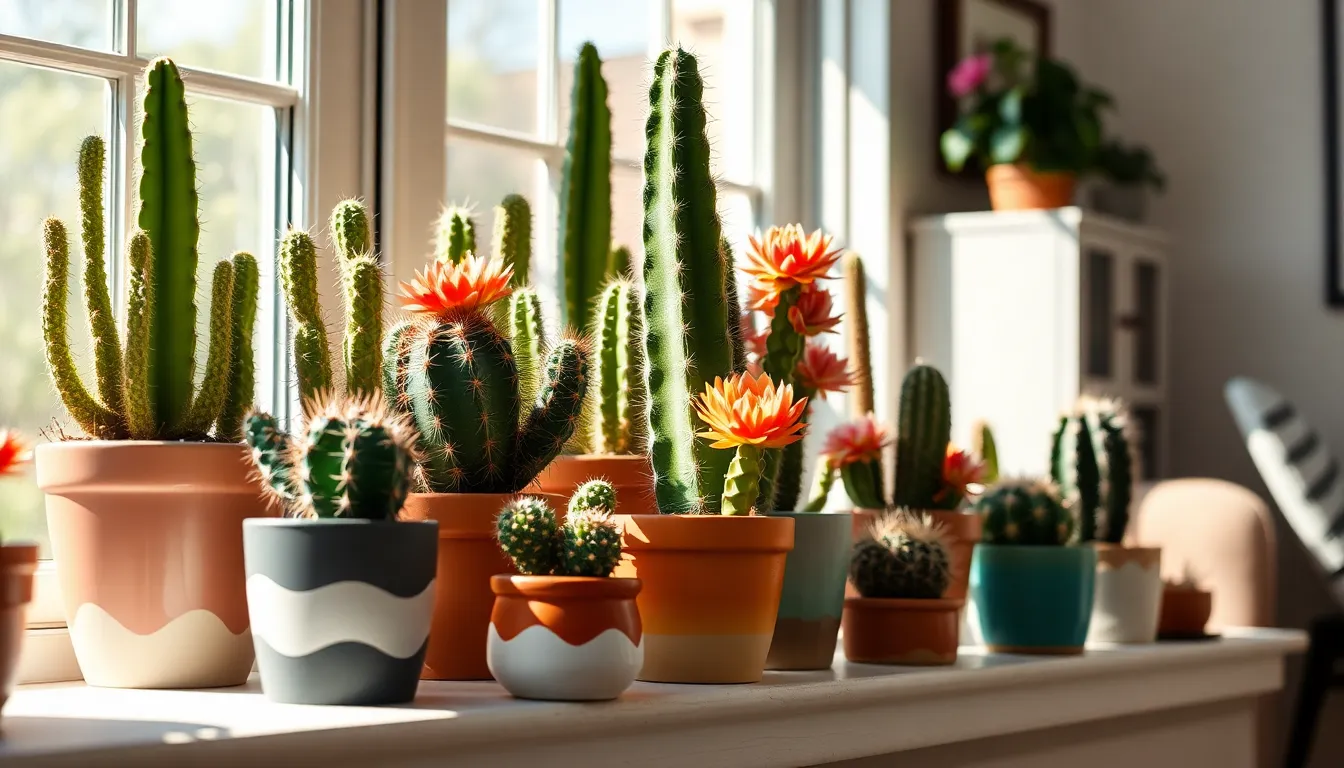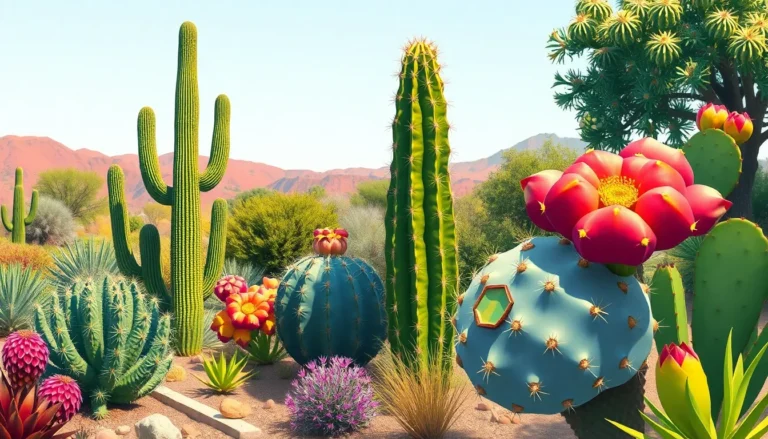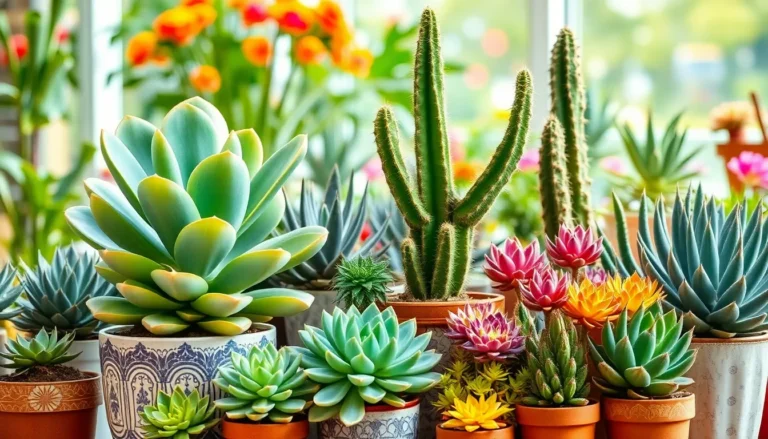Cacti are the ultimate low-maintenance houseguests. They don’t demand daily attention, won’t judge your questionable taste in music, and thrive on neglect. These quirky plants, with their stunning shapes and vibrant blooms, add a pop of personality to any space—without the need for constant watering or fancy fertilizers.
Imagine a plant that can survive a desert drought and still look fabulous on your windowsill. Cacti come in all shapes and sizes, making them perfect for any decor style. Whether you’re a seasoned plant parent or just starting out, these spiky wonders are here to brighten your home and your mood. So why not embrace the prickly charm of cacti? They’re not just plants; they’re the perfect companions for those who love a little sass in their greenery.
Cacti Plant
Cacti belong to the family Cactaceae and thrive in arid environments. These plants exhibit unique adaptations that allow them to store water in their tissues, enabling survival in drought conditions. Most cacti feature spines instead of leaves, which reduce water loss and provide protection from herbivores. Shapes and sizes vary significantly, from minute varieties measuring a few inches to towering species reaching several feet tall.
Vibrant blooms often emerge in various colors, typically during the spring and summer months. These flowers attract pollinators like bees and butterflies, ensuring successful reproduction. Many cacti are also known for their impressive ability to photosynthesize using a process called CAM, which minimizes water loss while converting sunlight into energy.
Cacti make excellent indoor plants due to their low maintenance needs and resilience. They adapt well to a range of indoor conditions, requiring minimal watering and indirect sunlight. Temperature fluctuations don’t deter these hardy plants; some can withstand extreme heat, while others tolerate cooler climates without issue.
Care for cactus varieties includes using well-draining soil and pots with drainage holes to prevent root rot. Fertilization isn’t necessary for healthy growth, although a diluted cactus fertilizer may promote flowering. Pruning, though rarely needed, may enhance appearance and support healthy growth.
Cacti garner a diverse following, appealing to both novice and advanced plant enthusiasts. The charm they bring to living spaces, along with their distinctive character, enriches any home environment. With their stunning forms and vibrant colors, cacti serve as an ideal addition to home decor.
Types Of Cacti Plants

Cacti come in various types, with each one adapted to specific environments. Two primary categories include desert cacti and tropical cacti.
Desert Cacti
Desert cacti thrive in arid conditions. They feature thick, fleshy stems to store moisture, allowing them to endure prolonged droughts. Many possess spines instead of leaves, which serve to reduce water loss and protect against herbivores. Examples include the iconic Saguaro and the Barrel cactus. These plants typically bloom vibrant flowers in spring, attracting pollinators with their bright colors. “Golden Barrel” cacti, recognized for their spherical shape, can grow over three feet tall. Desert cacti require minimal watering, often being watered every few weeks during the growing season.
Tropical Cacti
Tropical cacti flourish in humid, warm environments. These types often exhibit flat, paddle-like segments, making them distinct from their desert counterparts. Species such as the Christmas cactus and the Easter cactus fall into this group, known for their stunning, colorful blooms during holiday seasons. Tropical cacti prefer well-draining soil but also require more frequent watering compared to desert varieties. They thrive in bright, indirect light, making them suitable for indoor settings. Many tropical cacti produce flowers that attract unique pollinators like hummingbirds and moths. Regular care facilitates lush growth and brilliant flowering displays.
Benefits Of Cacti Plants
Cacti plants offer numerous advantages, making them valuable additions to any home or environment. Their unique attributes provide both environmental and health benefits.
Environmental Benefits
Cacti improve air quality by absorbing carbon dioxide and releasing oxygen through photosynthesis. They also play a role in reducing heat, acting as natural insulators for surrounding areas. Storing water within their tissues allows cacti to thrive in low-water environments, thus conserving water resources. Additionally, many cacti species support local ecosystems by attracting pollinators, contributing to biodiversity.
Health Benefits
Cacti contribute beneficially to indoor environments, promoting overall well-being. Their presence can reduce stress and increase happiness, enhancing mental health. Some studies indicate that cacti may help lower the risk of certain illnesses due to their unique properties. Additionally, the moisture in the air around cacti can improve humidity levels, benefiting respiratory health. Their vibrant colors and shapes elevate mood and enrich home decor, creating a calming atmosphere.
Care And Maintenance
Cacti require specific care to thrive indoors, focusing on watering and light for optimal growth.
Watering Requirements
Cacti thrive on minimal watering. It’s important to water them infrequently, allowing the soil to dry out completely between waterings, usually every two to three weeks. Overwatering can lead to root rot, so ensuring proper drainage is essential. During the growing season in spring and summer, increased watering may be necessary, but this should be monitored closely. In winter, cacti enter dormancy and require even less water, adapting to their natural habitat’s dry conditions. Checking the soil moisture with a finger can help determine when to water.
Light Conditions
Cacti prefer bright, indirect sunlight. Placing them near a south or west-facing window offers optimal exposure, ensuring they get enough light without direct scorching. While desert cacti need more sunlight, tropical varieties thrive in filtered light. This balance promotes healthy growth and flowering. Insufficient light causes cacti to etiolate, leading to elongated and weak growth. Regularly rotating the cactus can help enhance light exposure on all sides.
Common Issues
Cacti can encounter several common issues affecting their health and appearance. Understanding these problems facilitates effective care.
Pest Problems
Pests like mealybugs, spider mites, and scale insects often target cacti. These pests suck sap from the plant, weakening it. Active observation helps identify infestations early. If noticed, isolating the affected cactus prevents the spread to other plants. Treatments include insecticidal soap or neem oil, both effective in controlling pest populations. Regular inspection and maintaining proper conditions reduce pest occurrence.
Diseases
Diseases such as root rot and fungal infections pose serious risks to cacti. Root rot occurs when cacti are overwatered, leading to mushy roots and discoloration. Identifying early signs is essential; affected plants require repotting in dry, well-draining soil. Fungal infections often manifest as brown spots or decay. Ensure good air circulation around cacti to discourage fungal growth. Utilizing antifungal treatments can aid recovery, but prevention through proper care practices is crucial.
Conclusion
Cacti stand out as remarkable houseplants that combine beauty with resilience. Their unique adaptations and minimal care requirements make them perfect for anyone looking to enhance their living space without the burden of constant maintenance. With their striking shapes and vibrant blooms they not only add character but also contribute to a healthier indoor environment.
Whether it’s the hardy desert varieties or the lush tropical types each cactus brings its own charm. By understanding their specific needs and potential challenges plant enthusiasts can enjoy the many benefits these fascinating plants offer. Embracing cacti can transform any home into a serene oasis filled with life and color.




